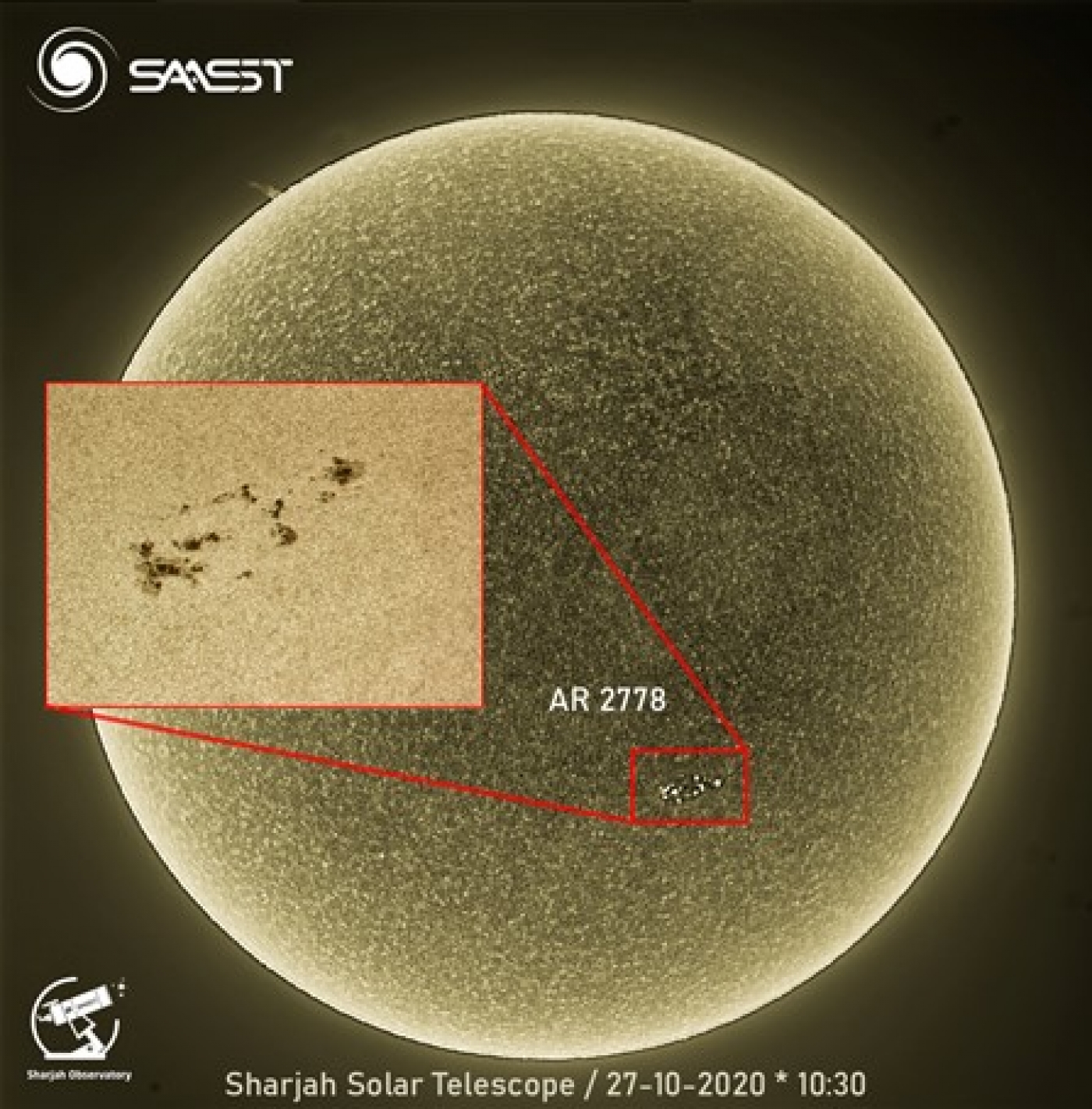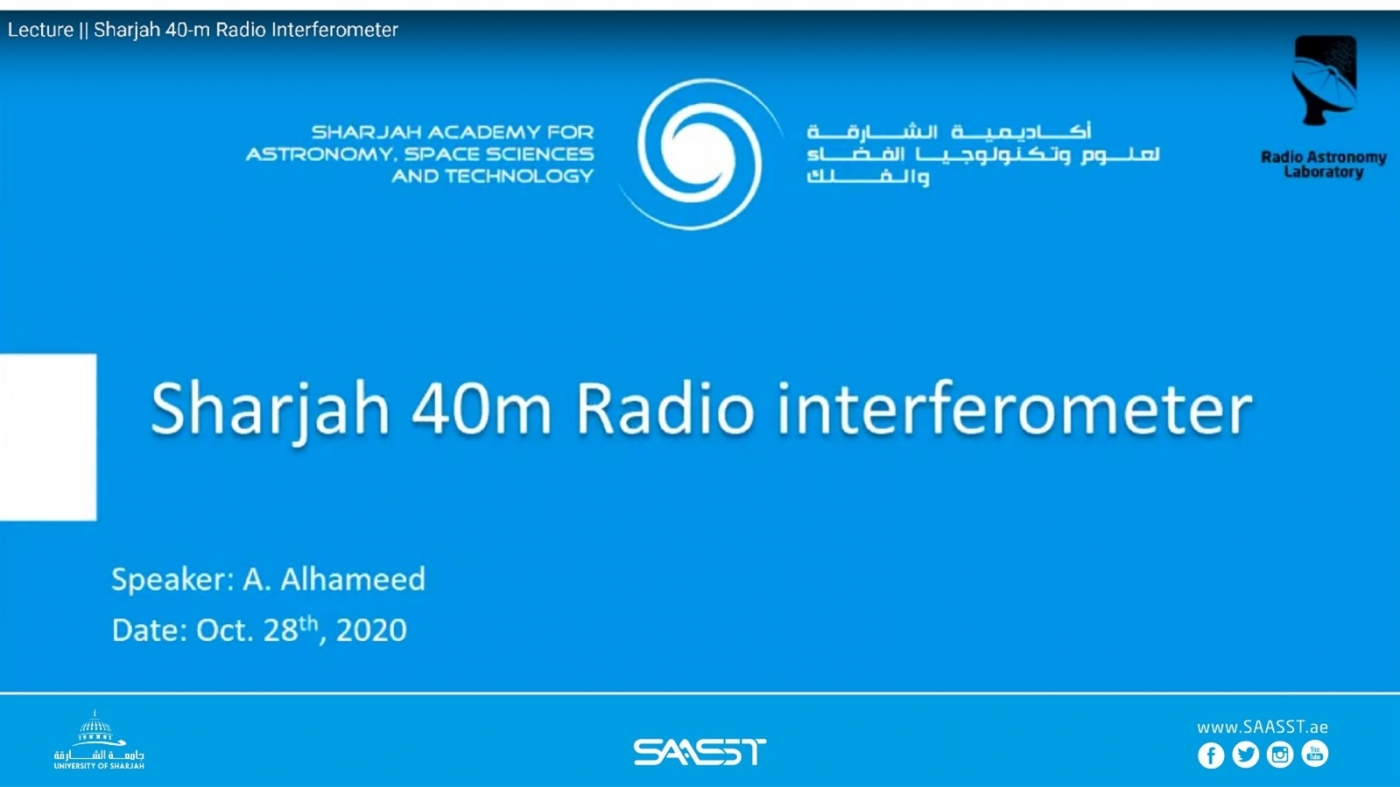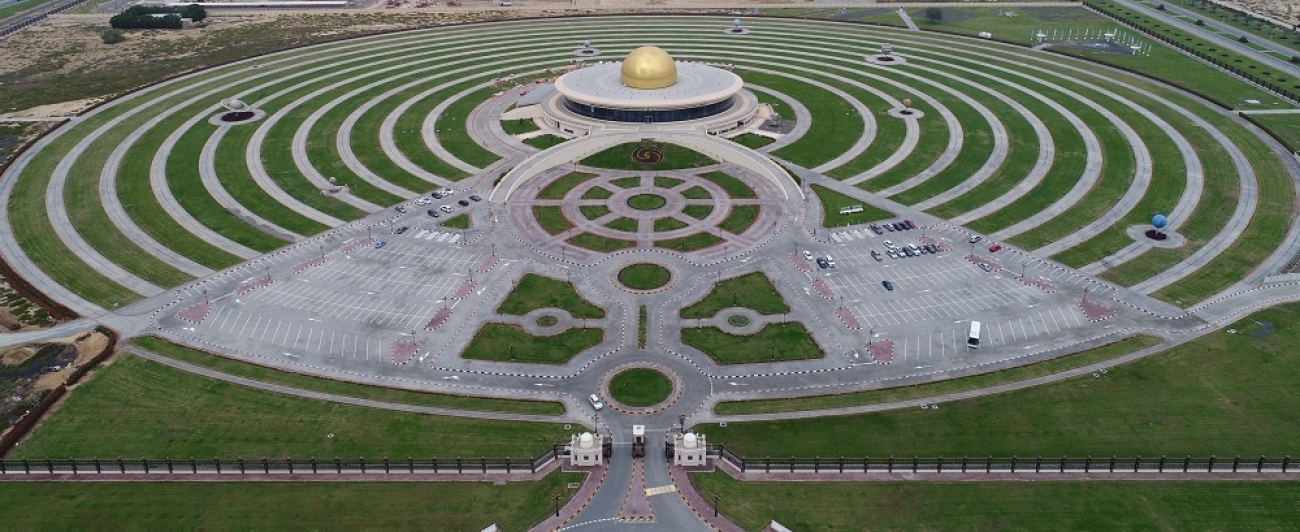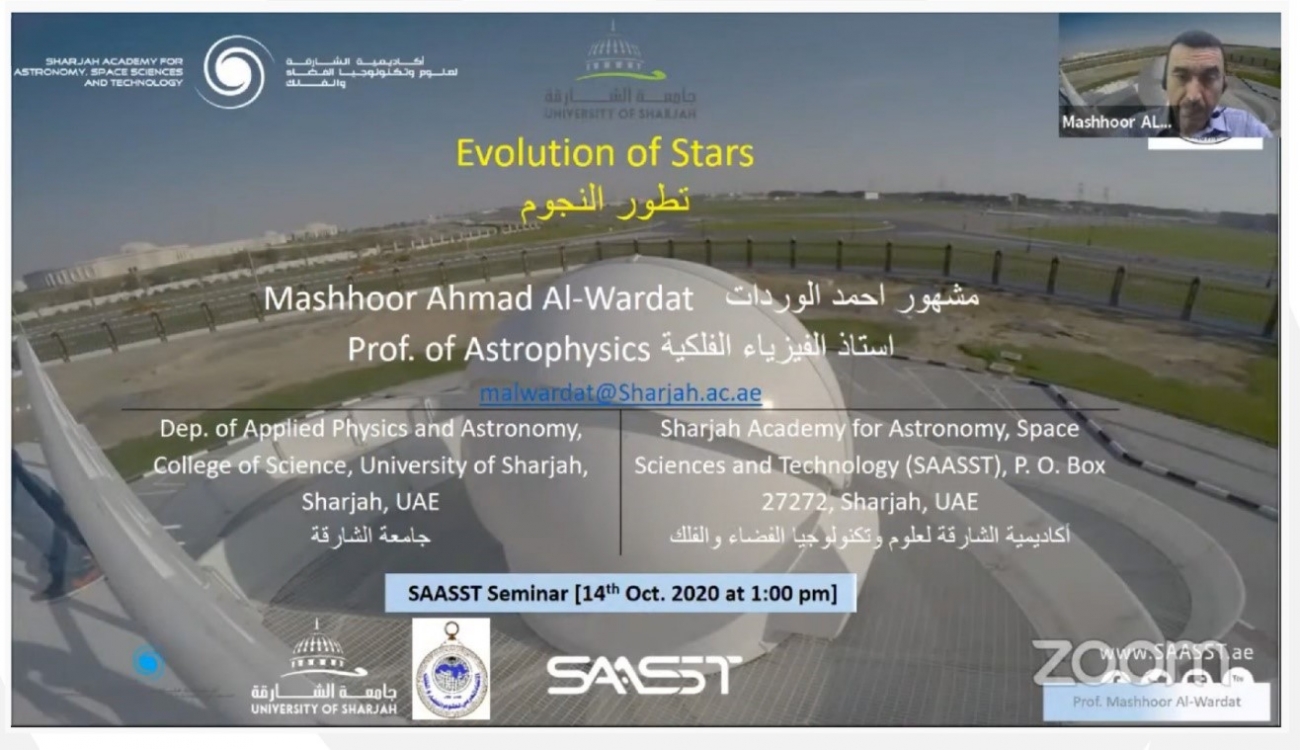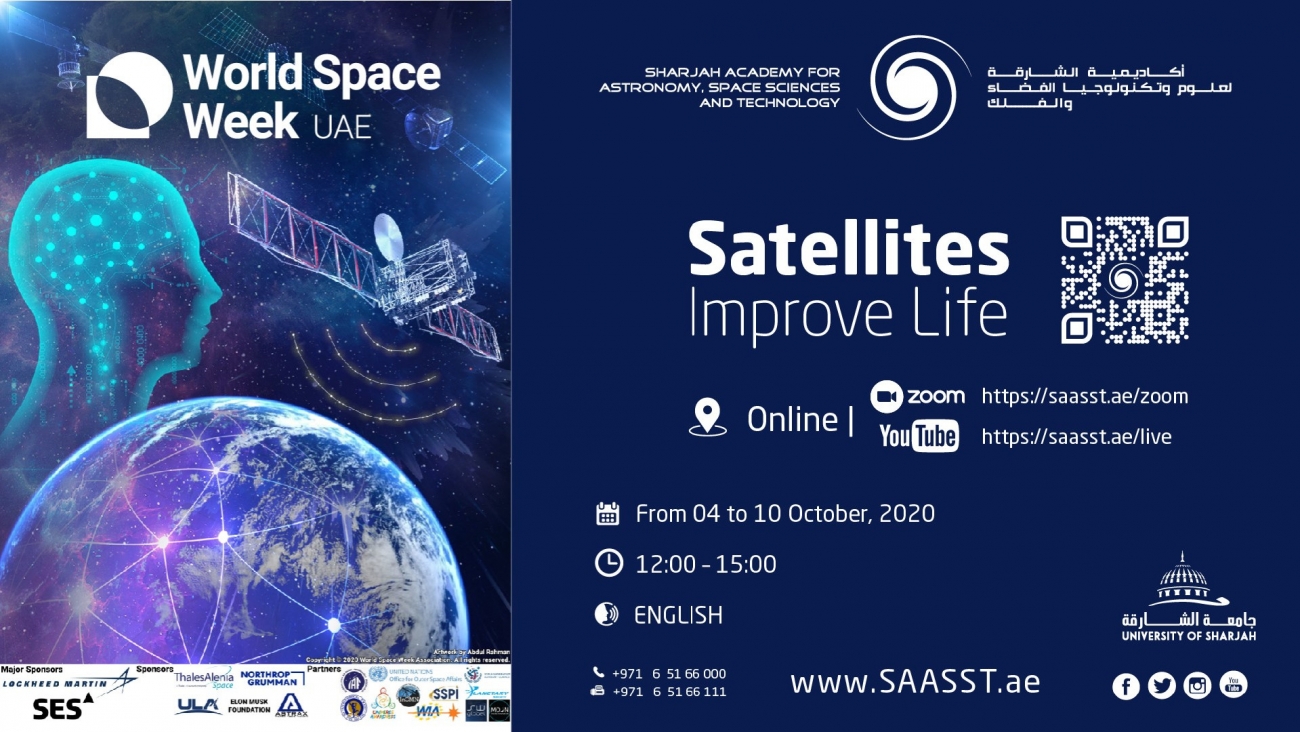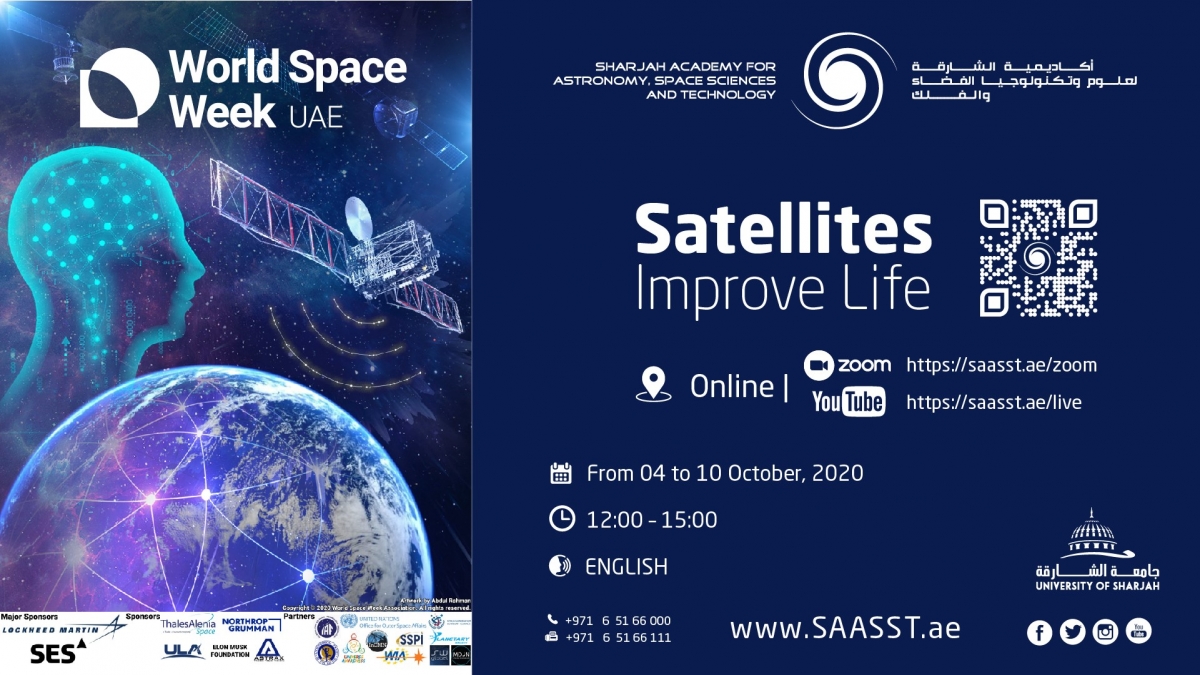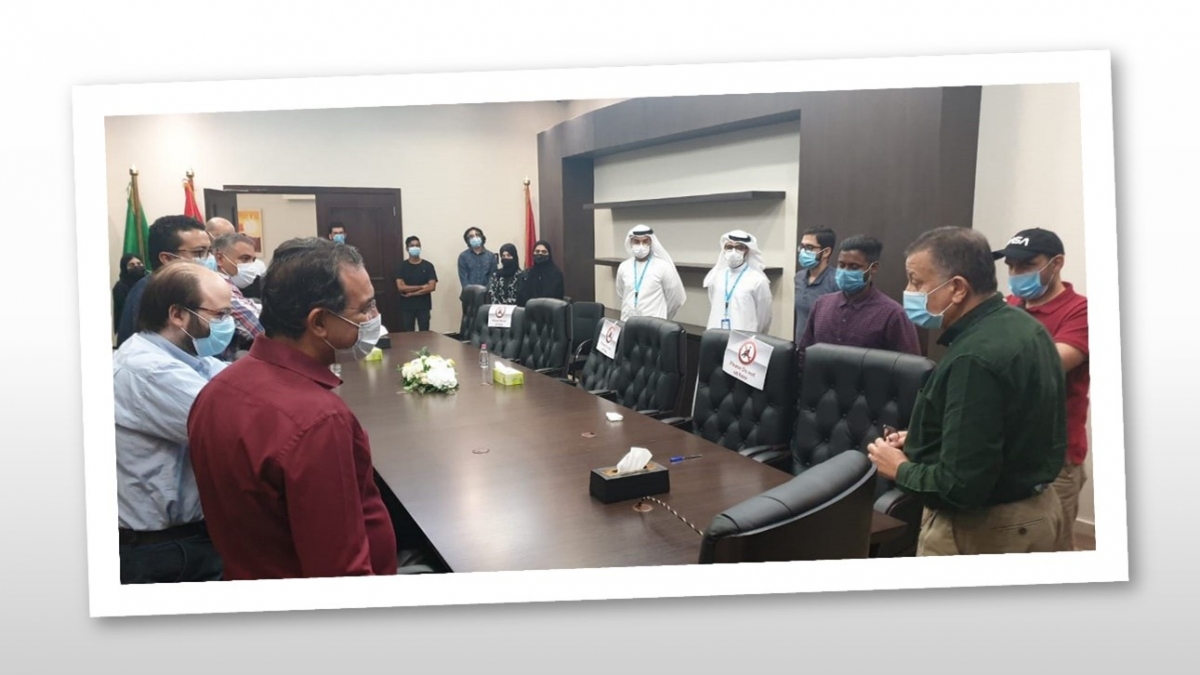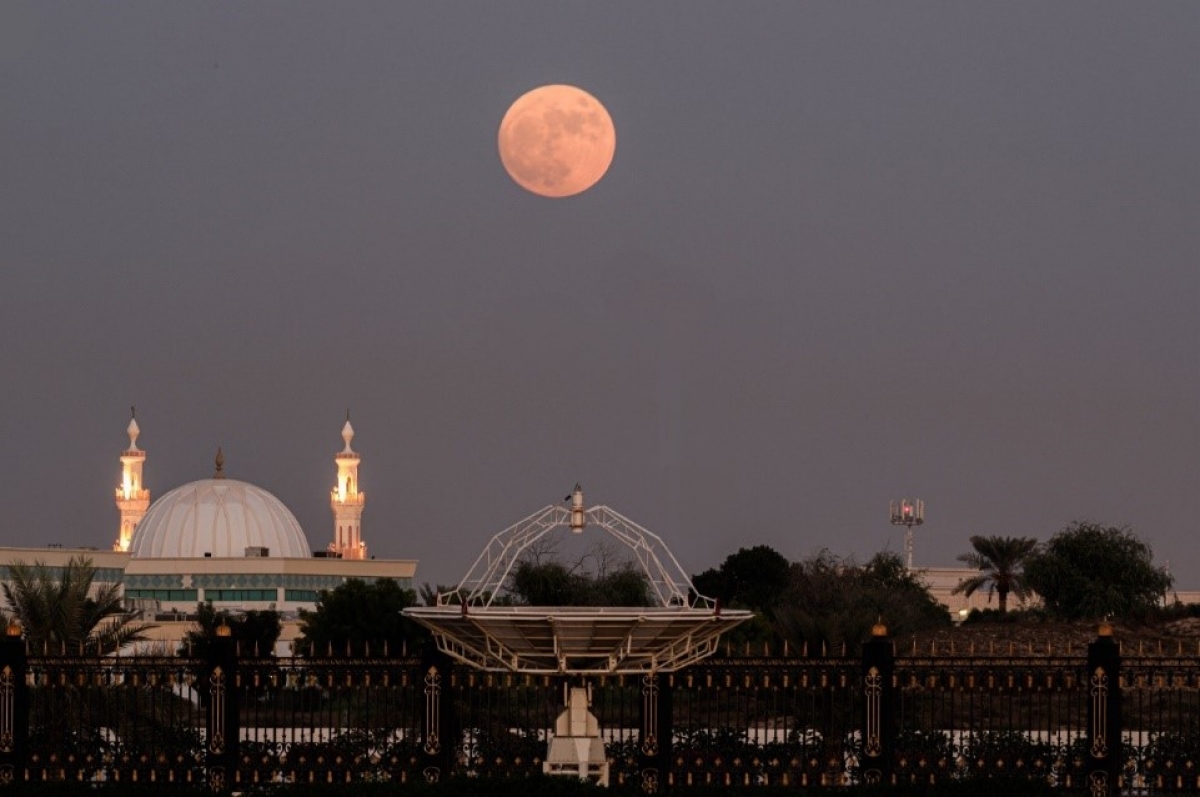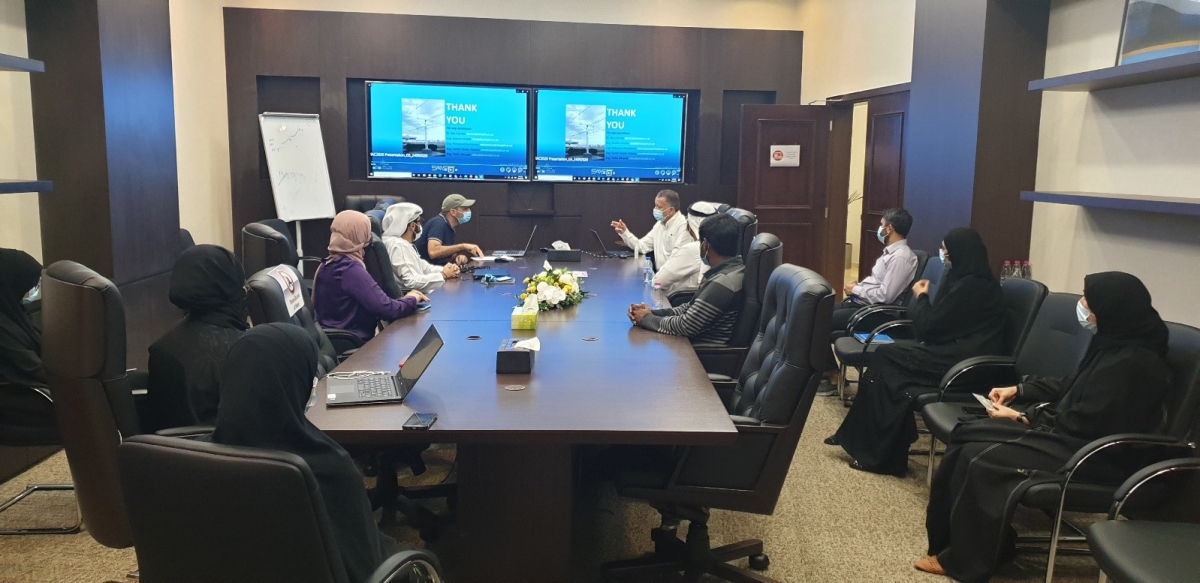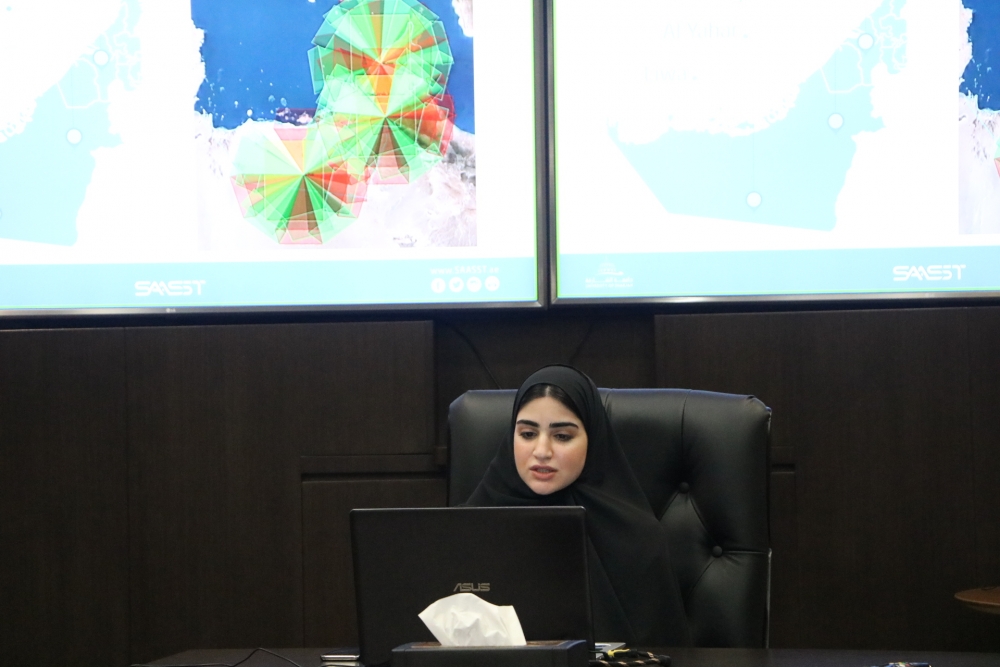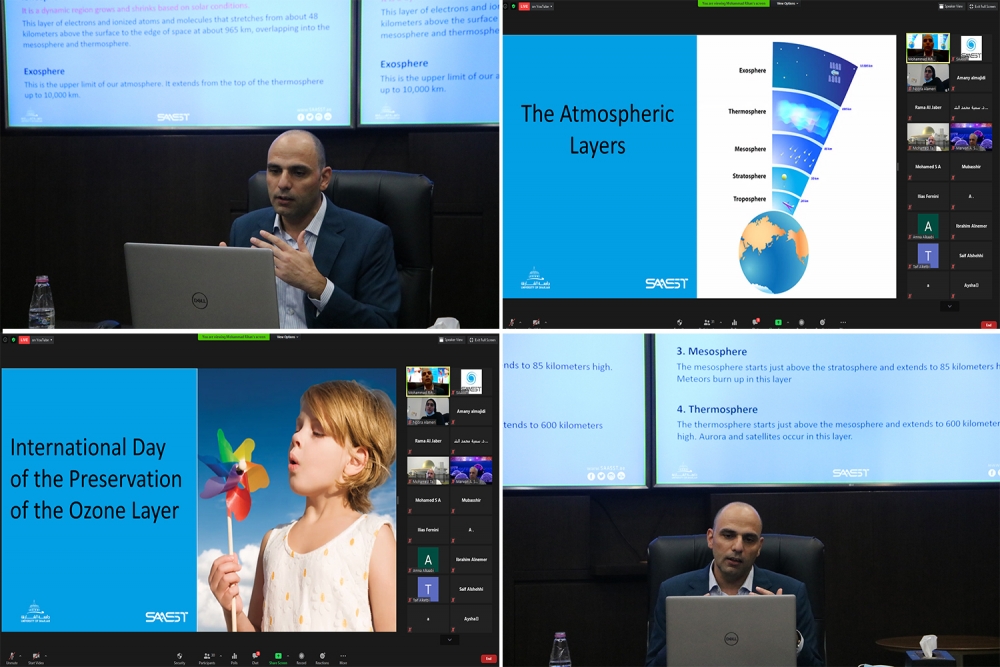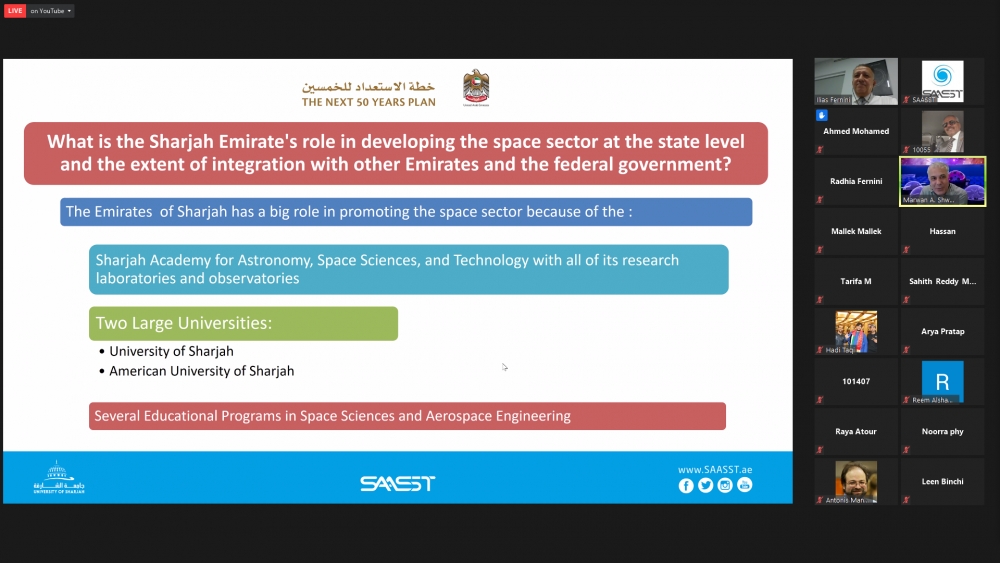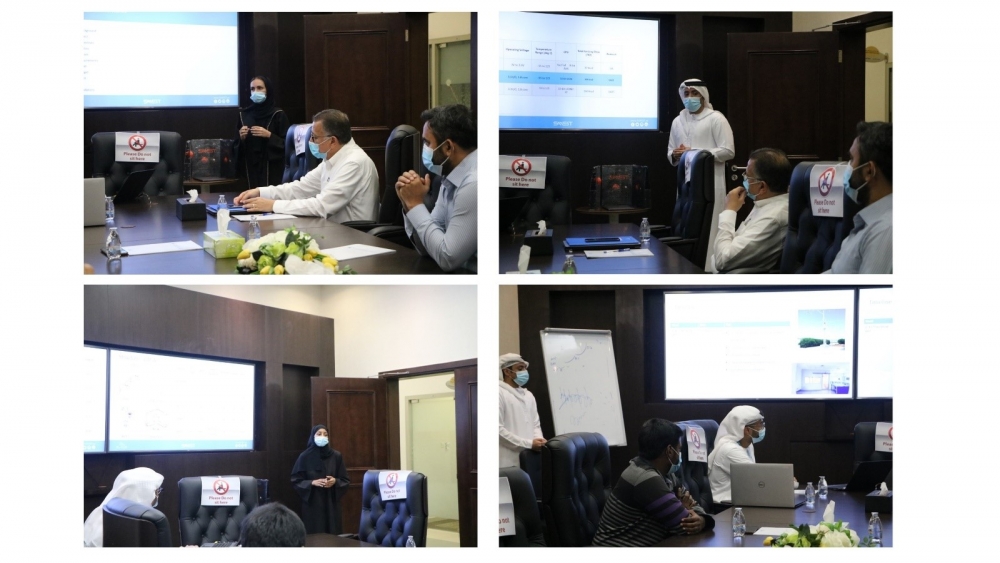SAASST on "spaceweather.com"
A nice picture of the sunspot AR2778 appeared on the "spaceweather.com" website on Oct. 27, 2020. The picture was taken by Mr. Mohamed Talafha from the Sharjah Academy for Astronomy, Space Sciences, and Technology. AR2778 is the biggest sunspot of young Solar Cycle 25, with nearly a dozen dark cores spawling almost 100,000 km across the solar surface. The picture was taken using the 10 cm solar telescope at the SAASST Sharjah Optical Observatory with an H-Alpha filter. The zoomed insert is with a white light filter. More sunspots of the new Solar Cycle 25 are appearing over the hours, recently sunspot AR2779 in addition to AR2778.
SAASST’s Lecture: 40-m Radio Interferometer
As part of its bi-monthly lecture, the Sharjah Academy for Astronomy, Space Sciences, and Technology organized a virtual lecture on the SAASST 40-m radio interferometer on Oct. 28, 2020. The lecture was given by Ms. Asmaa Al-Hameed, a research assistant in the “Radio Astronomy Laboratory.” Ms. Asmaa gave a general introduction to the different types of radio waves used for different applications and emphasized the one used primarily for radio astronomy. A brief history of the detection of the galactic and extragalactic radio signals was also presented.
SAASST Planetarium is the Center of Arab Planetariums
His Excellency Prof. Hamid M.K. Al Naimiy, Chancellor of the University of Sharjah, President of the Arab Union for Astronomy and Space Sciences, and General Director of the Sharjah Academy for Astronomy Space Sciences and Technology (SAASST), announced the establishment of the Arab Planetariums Society. The new Society is to stress the importance of such an institution in the Arab world at the present time. He also declared SAASST's Planetarium as the focal point for planetariums in the Arab world. This announcement came during Prof. Hamid's opening speech at the Arab Space Week conference held by the Arab Union for Astronomy and Space Sciences in cooperation with the Regional Centre for Space Science Technology Education for Western Asia (RCSSTEWA). SAASST actively participated in the event.
SAASST’s Lectures Stellar Evolution by Prof. Mashhoor Wardat
The Sharjah Academy for Astronomy, Space Sciences, and Technology has organized a lecture on Wednesday titled “Stellar Evolution.” The lecture was presented by Prof. Mashhoor Wardat, SAASST Deputy General Director for Academic Affairs. These lectures are organized every two weeks for the general purpose of promoting astronomy education to SAASST employees and students and the general public. Prof. Mashhoor covered the evolution of stars from their molecular clouds stage to their cradle. Stars have different evolutionary tracks depending upon their stellar masses, one of the most important physical properties of a star. The type of chemical elements a star can produce depends upon its mass as well as its faith. Our star, the Sun, is presently in its main sequence phase fusing Hydrogen to make Helium. Once 90% of the Hydrogen is consumed, the Sun will move to its second phase, fusing Helium to make Carbon. And this will be it. Our star will then become a white dwarf with no more nuclear fusion.
SAASST World Space Week 2020 Activities - “Satellites Improve Life”
World Space Week is an UN-declared celebration of space held annually, every October 4 to 10. It is the largest space event on Earth, with over 8,000 events reported in 2019 and held in 96 countries. These events are organized by thousands of organizations, including space agencies, aerospace companies, astronomy clubs, and museums. In 2020, World Space Week is dedicated to satellites, and their broad benefits under the theme “Satellites improve life.”
SAASST Participates in the 71st International Astronautical Congress 2020 Cyber Space Edition
The 71st International Astronautical Congress, IAC 2020, is organized as a Cyberspace Edition without registration fee, free of charge for a global community. This will allow the International Astronautical Federation (IAF) to reach out to new communities and stakeholders that would typically not have the means and/or time to travel to an IAC physically.
World Space Week 2020 “Satellites Improve Life”
World Space Week is an UN-declared celebration of space held annually, every October 4 to 10. It is the largest space event on Earth, with over 8,000 events reported in 2019 and held in 96 countries. These events are organized by thousands of organizations, including space agencies, aerospace companies, astronomy clubs, and museums. In 2020, World Space Week is dedicated to satellites, and their broad benefits under the theme “Satellites improve life.”
Farewell Ceremony to Mr. Sahith Madara, SAASST Research Assistant
The Sharjah Academy for Astronomy, Space Sciences, and Technology has organized a farewell ceremony to Mr. Sahith Madara, a SAASST research assistant at the CubeSat Laboratory. Mr. Sahith is leaving us to start an MSc. program in space engineering in France. Mr. Sahith has been working with us for more than two years.
Harvest Moon 2020
The Harvest Moon is the closest full Moon to the autumnal equinox (usually Sep. 22). Its name refers to centuries ago during the harvest season when the farmers need to work late into the night using the help of the Moon's light. In most years, the Harvest Moon falls in September, but this is one, it falls in October. From UAE, the Harvest Moon will be on Thursday, Oct. 1, 2020, appearing opposite the Sun at 18:05 local time.
SAASST Research Assistants Rehearse for IAC 2020 Cyber Space Edition
For the IAC 2020 Cyber Edtion (Oct. 12-14, 2020), SAASST had eight research papers accepted for this prestigious conference. Due to the pandemic, the organizers requested a video to be prepared for each paper and sent to IAC before Sep. 25, 2020.
More...
SAASST Organizes a Highly Informative Lecture on the UAEMMN Project in Collaboration with the UAE Space Agency
The Sharjah Academy for Astronomy, Space Sciences, and Technology (SAASST) at the University of Sharjah organized a highly informative lecture on the ongoing UAE Meteor Monitoring Network project in collaboration with the UAE Space Agency. This lecture comes as part of SAASST's series of general lectures for the Academic Year 2020/2021 that it holds on the second and fourth Wednesday of every month.
International Day of the Preservation of the Ozone Layer
A very informative virtual lecture was given by Mr. Mohamed Baker Rihan on September 16, 2020, at SAASST as part of the Wednesday’s Lectures Series. The occasion was the “International Day of the Preservation of the Ozone Layer.” The United Nations General Assembly designated September 16 as the International Day for the Preservation of the Ozone Layer.
The Next 50 Years Plan - SAASST Starts its Series of General Lectures for the Academic Year 2020/2021
Under the patronage and with the support of His Excellency Prof. Hamid M.K. Al Naimiy, Chancellor of the University of Sharjah, General Director of the Sharjah Academy for Astronomy, Space Sciences, and Technology (SAASST), and President of the Arab Union for Astronomy and Space Sciences, SAASST is starting its series of general lectures for the Academic Year 2020/2021.
Three HCT Students Finished their 14 Weeks Summer Internship at SAASST
After 14 weeks of hard work, three Students from the Sharjah High College of Technology finally finished their summer internships at the Sharjah Academy for Astronomy, Space Sciences, and Technology. The students were enrolled in the CubeSat Laboratory as it was related to their background as Engineers.



